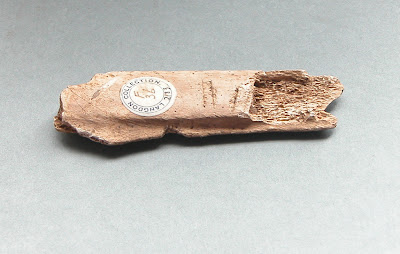The purpose of Black History Month is to acknowledge the contribution that people of African descent have made to history, so that they can celebrate their ancestral heritage and it can be embraced by all people in British society. It was started in 1987 and continues to be celebrated in October every year with a range of events celebrating the African diaspora (people of African descent 'dispersed' around the world).
 |
| Family photograph from Claudia Rennie |
It is commonly thought that people of African descent were absent from Britain Jamaica British Isles since at least the 3rd century AD, when an African division of Roman soldiers is believed to have been stationed at Hadrian’s Wall . References are made to black people living in Bedfordshire from 1661 in Parish Registers, which note both baptisms and funerals.
 |
| Extract of William Rudd's will leaving part of his estate and an annual stipend to his maid servant Sabina. Courtesy of BLARS, Ref: abp-wl745-22 |
A connection existed between the Caribbean and Bedfordshire sometimes as a result of local ownership of plantations by wealthy land owners. For example, the Payne family had plantations in St Kitts from the beginning of the eighteenth century. There were individuals locally that also fought for the abolition of slavery on plantations, including Henry Thornton of Moggerhanger Park. Occasionally plantation owners would bring their maid and man servants with them back to England when they visited. One of the few black maid servants mentioned in the Bedfordshire archive records, but who we know very little about how she came to Bedfordshire, is Sabina who was employed by William Rudd of Carlton. He specified in his will that ‘Sabina the black’ would live in a cottage as part of his estate with a stipend of £5 per annum. Sabina became the first black woman to be recorded to marry in Bedfordshire. She wed Robert Newton at St. Paul’s Church on the 23rd December 1745.
 |
| Moggerhanger Park, originally home to the Thornton family and supporters of the anti-slavery campaign. |
Discrimination against black people is reported in the Bedford Bee local newspaper
Jamaican born Joe Clough became a local celebrity in Bedford Bedford France
 |
| Joe Clough in front of the ' Poppy Bus', Eastern National Omnibus Company, who Joe worked for from 1919 until 1947. Courtesy of BLARS Ref: Z1306/13uncat |
Ten years ago Bedford Museum Caribbean coming to Bedford Caribbean came to England
Here is an extract from an interview with Josephine Corrion, who shared her story with us of coming to
“I was born in Carriacou, sister island of Grenada Trinidad to get married, that was 1954 and in 1955 my first child was born. I lived there for 7, 8 years. I’ve got four children and 3 of my 4 children were born in Trinidad …My husband got a job; my brother got him a job at the Britannia steelworks, iron foundry …I took a job on a farm planting peas and beans and potato. There were hundreds of us on that ship and my brother was waiting for me and we boarded a train. It took about a week and a half …when we arrived at Southampton the immigration …officers were nice.
I applied at Bromham Hospital, domestics and … I got a letter telling me that (I had) an interview … When I got there the Matron called me in and she … asked me all sorts of questions and I answered, to the best of my ability and in the end she said “I’m sorry Mrs Corrion, I haven’t got a job for you as a domestic”. I thought to myself “Oh no, you’ve kept me talking all this time and she hasn’t got a job for me”. She said “But I have got a vacancy for a nursing assistant. Would you like that?” I said “Oh please.” … I was accepted and that was in 1963 and I worked there, in Bromham Hospital
“I must tell you the Bedford Carnival started in my dining room!
My daughter Elma being born in Trinidad and always hav(ing) the sound of the steel band drum in her head. She started it. I explained how things should be done and what they should do and do it on the cheap and they did. She had open(ed) up a workshop and the people bought their costume themselves. It went for three years and I don’t really know what happened. Bedford Carnival is no more, but it was nice, it was nice.”
Before Bedford Museum
“I am very lucky that Mrs Brown works at my school St Gregory’s, so I was amongst the first to join Utopia Mas when she started it. I have always liked singing and dancing so this was a great way to meet new people, have fun and learn new dances. As part of the group, I have travelled to different carnivals all over the place from the local Luton carnival that is one of the biggest, all the way to the Isle of Wight . My favourite carnival was Notting Hill Gate because it was one of the largest carnivals I had been to. I had always wanted to go there from a young age and taking part in it was a very exciting time for me.
We’ve danced in the sunshine and also in the pouring rain but it was still fun being with all the friends I have made. Utopia Mas consists of many different schools with people from all ages. I am happy that I have been able to mix with people I never would have met if I hadn’t of joined the carnival band in the beginning of 2009.
I am now looking forward to 2010 and many more years of dancing and I hope they shall be bigger and better, and pray more people will join to make our dance group greater”.
Claire Collins, age 12, Utopia Mas participant.
Claire Collins, age 12, Utopia Mas participant.
Our next venture at the Art Gallery Bedford
The BACF are rounding up the Black History Month celebrations with their ‘We are Amazing Finale’. This is a culmination of events that have taken place during the month with a variety award show. It will be held at the Addison Centre, Kempston on Saturday 29th October, from . All are welcome! See their Black History Month Diary for ticket prices and further details.
Keeper of Social History
Acknowledgements:
Thanks to Bedfordshire and Luton Records and Archives Service (BLARS) for the information and image of William Rudd's Will and picture of Joe Clough.
Thanks to the participants of 'The Front Room' exhibition for their photographs.
Thanks to Utopia Mas for giving us permission to show their photographs.
Acknowledgements:
Thanks to Bedfordshire and Luton Records and Archives Service (BLARS) for the information and image of William Rudd's Will and picture of Joe Clough.
Thanks to the participants of 'The Front Room' exhibition for their photographs.
Thanks to Utopia Mas for giving us permission to show their photographs.

































